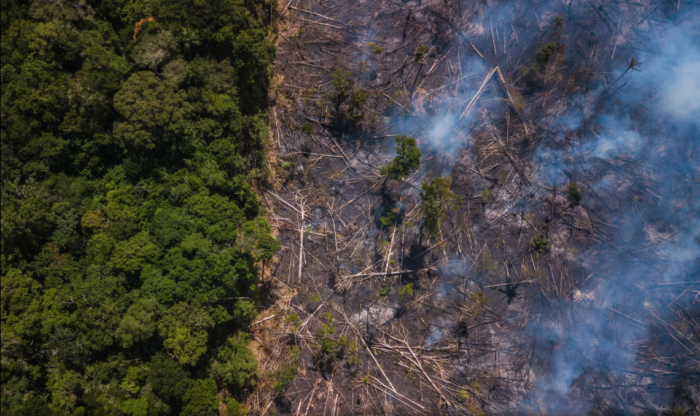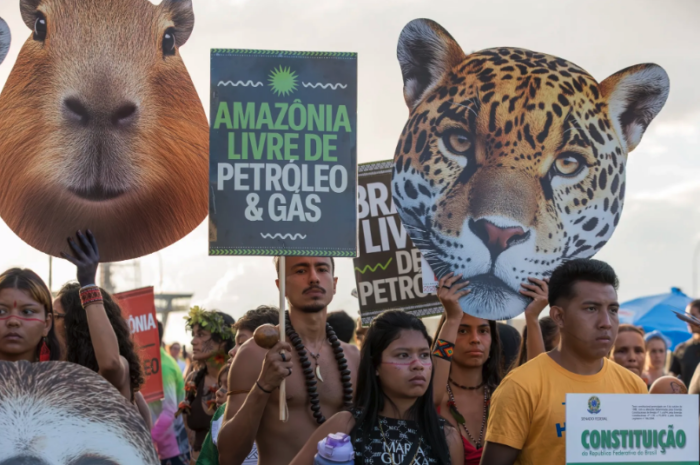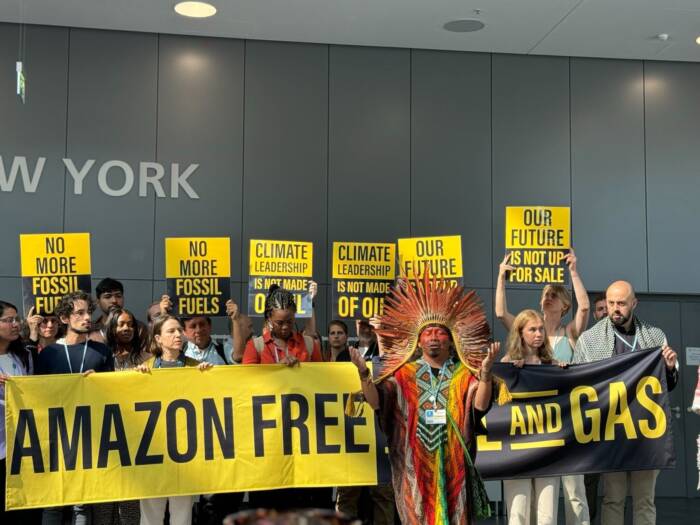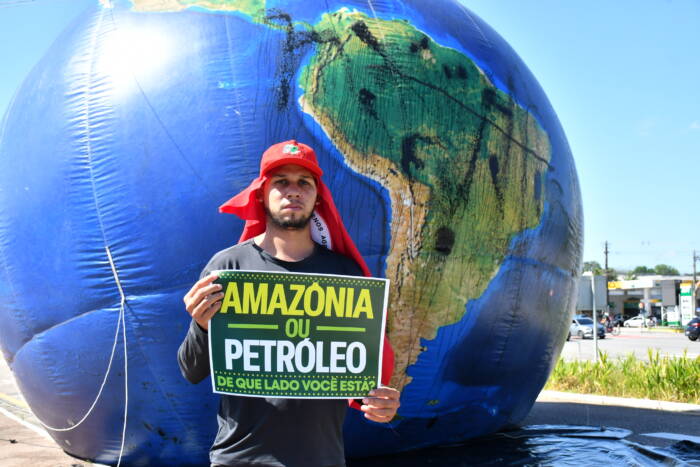By SOS Amazonia & 350.org
When someone thinks about the Amazon forest, it’s likely that long rivers, lush green trees, giant anacondas and Indigenous Peoples’ cultures come to mind. Clichês aside, the Amazon is indeed a place of unimaginable beauty, astonishing cultural variety and crucial biodiversity. But all of that is currently under alarming threat: deforestation and oil and gas drilling are putting the forest and its people at risk.
Deforestation and Wildfires
Deforested areas in the Amazon increased by 91% in May 2025, according to data from the Brazilian National Institute for Space Research (INPE) released on July 6. This marked the second-worst result in the historical series for that month, with 960 km² of forest cleared – that’s equivalent to the size of 137 soccer fields or the whole country of São Tomé and Principe, in just one month!
Data released in April 2024 by the Amazon Institute of People and the Environment (Imazon) also show that 79% of recent deforestation occurred on private land (such as farms), with 16% in settlements, 5% in conservation units, and 1% in Indigenous territories.
The link between deforestation and illegal wildfires is evident, as fire is often used as a tool for “clearing land.” As stated by Dr. Luciana Vanni Gatti, a researcher at INPE, “the surge of wildfires currently affecting Brazil is not a natural phenomenon.” Several industries in Brazil — agribusiness, livestock, mining, oil, and energy — profit from illegal deforestation. As explained by the president of IBAMA, Rodrigo Agostinho, in August 2024: “Cutting trees is expensive. Fire is much cheaper — you just buy gasoline and start spreading it.”

Amazon forest is undergoing rapid deforestation using fire. Photo: Bloomberg Finance LP
The loosening of environmental legislation further complicates monitoring and enforcement efforts. The so-called Deforestation Law Project (Bill 2159/2021) was approved by the Federal Senate on May 21 and by the Chamber of Deputies on July 17, 2025. Introduced by the agribusiness caucus, the bill weakens environmental licensing regulations and establishes a new legal framework to facilitate the regularization of development projects nationwide — a move that risks increasing both wildfire occurrences and deforestation rates.
Oil and Gas Industry
Beyond deforestation and wildfires, one of the most pressing challenges facing Amazonian communities today is energy insecurity and the threat of oil and gas exploration in crucial biomes.
The region generates nearly a third of Brazil’s electricity — mainly through large hydroelectric dams. And still, the Brazilian government insists on granting permits for dirty and outdated energy sources such as oil and gas, and millions of people in the Amazon still live without reliable access to power.
This destruction is not only an attack on biodiversity; it deepens the vulnerability of the very people who are most excluded from access to energy. Fires and fossil fuel projects that devastate forests also suffocate communities with smoke, contaminate water sources, and destroy the natural cycles that guarantee food and livelihood.
While the Brazilian government insists that oil will finance a just energy transition, the reality is that the expansion of extractive frontiers only fuels more violence, more inequality, and more blackouts in the lives of those who live in the Amazon.
Moreover, there is no concrete energy transition plan from the Brazilian government, with clear targets. A just energy transition cannot be born from destruction. A just transition cannot be built on destruction: it must start with the people who are paying the highest price for a crisis they did not create.

Amazon needs to be free from oil and gas so local communities stop living with the harms caused by these industries. Photo: Kathleen Lei Limayo
What Vulnerabilities Do Local Communities Face?
Interference in the forest affects ecosystems that should be protected — such as Indigenous lands and extractivist reserves (traditional forest communities who harvest without deforestation) — directly impact local communities and contribute to food insecurity.
In March 2024, Acre experienced severe flooding linked to climate change. Ninety-three Indigenous communities were affected, losing crops that would have sustained them for the entire year. And currently, the same state of Acre is facing one of its most severe droughts in recent years. According to the National Water Agency (ANA), over 64% of the state’s territory was affected by drought in May.
On the other side of the issue is the energy industry. In the Amazon, blackouts are not programmed or announced, they are the everyday reality. Without energy, there is no refrigeration for food or medicine, no internet connection, no pumping of clean water. In Belém and Manaus, for example, families often pay proportionally higher electricity bills than in other parts of Brazil, despite being surrounded by energy infrastructure.
The Government’s Contradiction and the Challenge of COP30
This stark contradiction highlights the urgency of a National Energy Transition Plan that is not only about cutting fossil fuels but also about ensuring access to clean, community-based renewable energy for those who have historically been excluded. For Indigenous peoples, riverine communities, and quilombolas, energy justice is not a luxury — it is a prerequisite for health, education, work, and the right to live with dignity.

Activists protest outside of international UN climate talks. Photo: 350.org
The Lula government is trying to present itself to the world as a climate leader by hosting COP30 in Belém. But how can this discourse be reconciled with the possibility of authorizing oil exploration at the Mouth of the Amazon, with the approval of the “Deforestation Bill,” and with entire communities living in the dark? There can be no international climate leadership without coherence at home. Opening new oil frontiers in the Amazon is drilling into the very heart of the global climate.
Why is it Important to Protect the Amazon?
At this critical moment — when climate change continues to break temperature records and the Earth edges closer to a point of no return — the Amazon Rainforest plays a vital role.
Spanning nine South American countries, the Amazon is one of the richest and most biodiverse ecosystems on the planet. As the world’s largest tropical forest, it is essential for sustaining life on Earth.
It functions as a carbon sink, absorbing CO₂ and helping combat the greenhouse effect. It shapes global weather patterns, prevents desertification, and is indispensable to climate stability.
Home to millions of people and uncountable species, the Amazon also provides valuable natural resources that support sustainable production chains, bioeconomic development, and above all, the food security of Indigenous and traditional communities.

Which side are you on? The Amazon or the oil industry? Photo: João Paulo Guimarães
Amazon Day: Let’s Take to the Streets!
This September 5th, Amazon Day, is not enough to celebrate: we must fight.
With the campaign The Answer Is Us and the global mobilization Draw the Line – Indigenous Peoples, riverine communities, quilombolas, urban youth, and social movements will take to the streets to draw the line against devastation and fossil fuels.
Brazil needs a National Energy Transition Plan that begins in the territories, guarantees clean and community-based energy for those who are currently excluded, and is built with real popular participation. The future will only be possible if it is just – and that justice begins now, with courage and mobilization.
On Amazon Day, we march because the future is not to be negotiated: it must be defended.
—
What is SOS Amazônia?
In the 1980s, large areas of forest in the Amazon were converted into grazing land. At that time, the rubber tappers’ movement in the state of Acre came together to resist deforestation and secure land rights for their settlements.
Driven by the resistance of the forest guardians, on September 30, 1988, in Rio Branco (Acre), teachers, university students, and representatives of the social movement—including activist and rubber tapper Chico Mendes—founded the SOS Amazônia Association. Its primary goal was to protect the Amazon Rainforest by supporting traditional populations.
Historically, SOS Amazônia has played a key role in developing management plans for several Conservation Units, including the creation and oversight of the Serra do Divisor National Park in Acre. Overall, the NGO planted more than 2.1 million trees and directly supported 5,500 families.
It also strengthened cross-border cooperation between Acre (Brazil) and Ucayali (Peru), encouraging the exchange of practices for the sustainable use of forest resources and monitoring actions to protect biodiversity. Through its Amazon Firefighters project, the organization has facilitated community dialogues on reducing the use of fire in agriculture among rural and extractivist communities.
The organization was recognized as one of the 100 Best NGOs in Brazil, receiving the award in 2017, 2021 and 2022. Organized by Instituto Doar, this recognition honors excellence in nonprofit management and transparency while fostering a culture of philanthropy in Brazil.
In 2004, SOS Amazônia also received the Bem Eficiente Award for institutional management, granted by Kanitz & Associados to the 50 non-profit organizations in Brazil that most effectively and transparently manage their resources.
How Can You Support Our Cause?
If you would like to learn more about our work and the Amazon forest communities, take a look on our website: https://sosamazonia.org.br/en
Sources:
Instituto Nacional de Pesquisas Espaciais – INPE (2025, June 6). TerraBrasilis: Deforestation alerts – Amazon biome (aggregated data). https://terrabrasilis.dpi.inpe.br/app/dashboard/alerts/biomes/amazonia-nb/aggregated/
Greenpeace Brasil. (2025, June 6). Desmatamento. https://www.greenpeace.org/brasil/tag/desmatamento/
Imazon. (2025, April). Sistema de Alerta de Desmatamento (SAD) – Março de 2025. https://imazon.org.br/publicacoes/sistema-de-alerta-de-desmatamento-sad-marco-de-2025/
SOS Amazônia. (2019, September 21). Brazil in flames. https://sosamazonia.org.br/tpost/uh70n228l1-brazil-in-flames
Menezes, R. (2024, August 7). Desmatamento é caro, fogo é mais barato, explica presidente do Ibama sobre queimadas. Agência Pública. https://apublica.org/2024/08/desmatamento-e-caro-fogo-e-mais-barato-explica-presidente-do-ibama-sobre-queimadas/
g1 Acre. (2025, June 28). Com mais de 64% do território em situação de seca, autoridades do AC avaliam estratégia para amenizar prejuízos. https://g1.globo.com/ac/acre/noticia/2025/06/28/com-mais-de-64percent-do-territorio-em-situacao-de-seca-autoridades-do-ac-avaliam-estrategia-para-amenizar-prejuizos.ghtml
g1 Acre. (2024, March 2). Da seca extrema à cheia histórica: entenda os fatores climáticos que fazem o Acre viver nova emergência. https://g1.globo.com/ac/acre/noticia/2024/03/02/da-seca-extrema-a-cheia-historica-entenda-os-fatores-climaticos-que-fazem-o-acre-viver-nova-emergencia.ghtml
SOS Amazônia. (2024, April 22). Dia da Terra: A importância da Amazônia para o futuro do planeta. https://sosamazonia.org.br/tpost/mj7i8xb6k1-dia-da-terra-a-importncia-da-amaznia-par